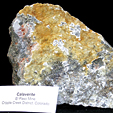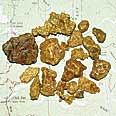All Articles
Legislative and Regulatory Update
August 2007 by Scott Harn
• This is a friendly reminder
September 1, 2007, is the deadline for mining claim holders to file the Maintenance Fee Waiver or pay fees to BLM to retain existing mining claims. Deadlines for filing with a county recorder vary by state, so check with your county if you do not know their requirements, fees or deadlines.
• Homebuilders’ case may help miners
The US Supreme Court recently decided a case that could prove helpful to miners. The case is National Association of Homebuilders v. Defenders of Wildlife.
It involved the Environmental Protection Agency’s decision to transfer permitting authority to the State of Arizona for permits issued under the National Pollution Discharge Elimination System (NPDES), which is mandated under the Clean Water Act.
The 9th Circuit Court of Appeals found that the Endangered Species Act gave the EPA the power and authority to deny transferring permitting authority to the state if threatened or endangered species would be harmed. The Supreme Court disagreed.
The Clean Water Act was originally passed in 1972. The Endangered Species Act was passed in 1973. The two Acts appeared to be in conflict.
Section 402(b) of the Clean Water Act says that if nine specific criteria are met, the EPA “shall” transfer NPDES permitting authority to the state requesting it, while the Endangered Species Act states that a federal agency must consult to “insure that any action authorized, funded, or carried out by such agency… is not likely to jeopardize the continued existence of any endangered species or threatened species.”
It is likely that NPDES permits issued by the State of Arizona will eventually result in a “take” of one or more endangered or threatened species.
The Supreme Court stated that “shall” transfer authority means there is no leeway for the EPA to deny the transfer of permitting authority. The Court ruled that the Endangered Species Act only applies to discretionary federal actions. In this case, the federal government must abide by the word “shall” and allow the transfer of permitting authority to the State of Arizona.
There are countless mining-related, non-discretionary activities that were pre-authorized by the 1872 Mining Law that have been deemed by lower courts to be in conflict with the Endangered Species Act. Some of these lower court rulings may now be in conflict with this Supreme Court ruling. It remains to be seen if government agencies and courts will comply with the ruling or try to circumvent it.
The case is National Association of Home Builders v. Defenders of Wildlife, Nos. 06-340 and 06-549, and it is available for review on our website. Click on Additional Resources and scroll down to “Court Cases” to view the Supreme Court decision.
• “Ecological resources must be protected…”
Though the California Regional Water Quality Control Board’s recent draft report doesn’t come right out and say it, it’s obvious by their wording that they intend to try to restrict or prohibit suction dredge mining, and quite possibly many other water-based activities that Californians enjoy.
The report states that streams must be maintained to provide a “dynamic equilibrium” between sediments and discharges, and that “instabilities” such as pools “lead to water quality problems and the destruction of stream habitats.”
There are 180 studies listed to back up their hypothetical situations and assertions. Notably absent are any of the studies that have shown that suction dredge mining is of insufficient significance to warrant further attention, or that suction dredges remove harmful contaminants, loosen compacted gravels for spawning areas, and lower water temperatures. Also absent are any economic studies that could show the agency that the current use of our waterways—by mining, fishing, boating and general recreation—creates jobs and income for citizens and businesses, and taxes for local and state governments. There is also no mention of the cost of additional bureaucracy to implement and oversee their forthcoming mitigation plans and restrictions.
The draft states, “Although this report has not focused on the impacts of land uses on stream and wetland system conditions, an underlying theme has been that key watershed variables and ecological processes must be protected or restored…”
It appears that a lawsuit will eventually be necessary to restore the rights of miners.![]()
Battle Heats Up Over California Suction Dredging
The State of California is seeking dismissal of the federal lawsuit filed by Public Lands for the People (PLP) on grounds that they are immune from such lawsuits under the 11th Amendment to the US Constitution. However, there is plenty of prior case precedence suggesting that state officials and agencies are open to such lawsuits when they assume responsibility for regulatory authority from the federal government.
Melman on Gold & Silver
Given that every single forecast of the level of government bailouts has understated the problems and the money required for solving them, one can only wonder what really lies in store for the American taxpayer—and the US Dollar.
The Mysterious Telluride Minerals
 …let’s dive in and take a closer look at these rich gold and silver-bearing minerals to find out what they are, where they form, and how to identify them.
…let’s dive in and take a closer look at these rich gold and silver-bearing minerals to find out what they are, where they form, and how to identify them.
Locating a New Nugget Patch
 Finding a new spot that is rich in gold, but has not already been exploited by other metal detector operators, is a goal of many prospectors. Sometimes it takes a lot of looking and research to find such a place because a lot of prospectors are out there...
Finding a new spot that is rich in gold, but has not already been exploited by other metal detector operators, is a goal of many prospectors. Sometimes it takes a lot of looking and research to find such a place because a lot of prospectors are out there...
Ask the Experts
Bismuth oxide for assaying?
Legislative and Regulatory Update
• California dredging update
• On a related issue, SB 233
• EPA and greenhouse gases
The Upper Susitna Goldfields
 The upper Susitna Goldfields, sometimes known as the Valdez Creek Mining District, are located 150 miles northeast of Anchorage off the Denali Highway in the Alaska Range. Though a small mining district, it was the “jewelry box” of the...
The upper Susitna Goldfields, sometimes known as the Valdez Creek Mining District, are located 150 miles northeast of Anchorage off the Denali Highway in the Alaska Range. Though a small mining district, it was the “jewelry box” of the...
Subscription Required:
The Bawl Mill
• Ask the Experts
• The Basics of Small-Scale Heap Leaching with Cyanide
• Will California Dredging Survive?
• Prospecting For Gold—The Osborne/Herman Hardrock Mine
• Journeys in the Kingman Quadrangle
• From Spanish Mine to Modern-Day Exploration: The Historic Gold-Silver Camp of Palmarejo
• Spanish Police Seize Ship in Treasure Fight
• Looking Back
• Gold Mine Proposed in Jefferson County
• Melman on Gold & Silver
• Mining Stock Quotes and Mineral & Metal Prices
Free:








